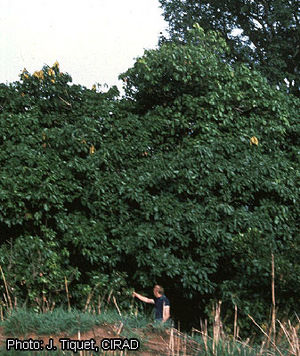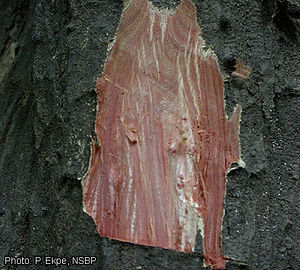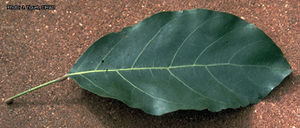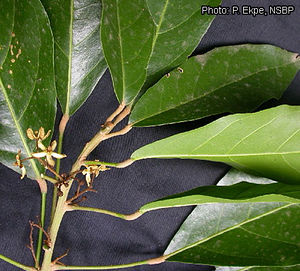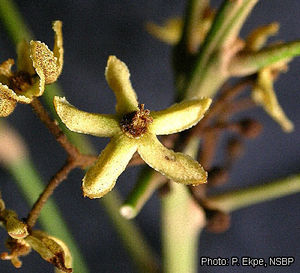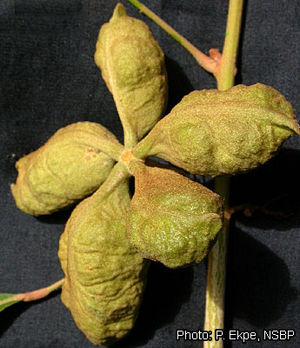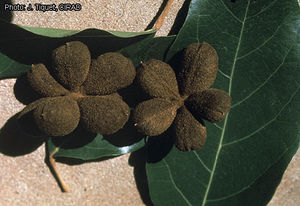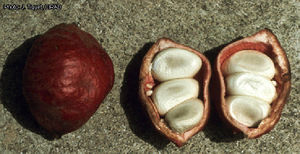Cola laurifolia (PROTA)
Introduction |
| General importance | |
| Geographic coverage Africa | |
| Geographic coverage World | |
| Fruit | |
| Dye / tannin | |
| Medicinal | |
| Timber | |
| Fuel | |
| Forage / feed | |
| Fibre | |
| Food security | |
Cola laurifolia Mast.
- Protologue: Oliv., Fl. trop. Afr. 1: 222 (1868).
- Family: Sterculiaceae (APG: Malvaceae)
- Chromosome number: 2n = 42
Vernacular names
- Laurel-leaved kola (En).
- Komonbélo (Fr).
Origin and geographic distribution
Cola laurifolia is distributed in West Africa from Senegal to Nigeria.
Uses
The wood of Cola laurifolia is used for making bows. Saplings are used for spear shafts in Nigeria. Twigs serve as chew-sticks. The wood is also used as firewood. The bark fibre is made into cordage. Bark of young saplings can be made into very fine cloth; it is also chewed by women to colour the mouth. The fruits are eaten raw and the foliage has been mentioned as a possible fodder. In Nigeria seed preparations are used against diarrhoea and dysentery. In Niger Cola laurifolia is made into love potions.
Properties
The wood of Cola laurifolia is yellow-grey. The texture is fine. The wood is strong and elastic, bending without breaking, but sometimes splitting.
Description
- Medium-sized tree up to 30 m tall, often low-branching with arching, sometimes rooting branches; bole up to 80 cm in diameter; young parts rusty stellate-hairy.
- Leaves alternate, grouped at the end of twigs, simple and entire; petiole 2–8 cm long; blade oblong, elliptical or oblanceolate, 5–25 cm × 2.5–13 cm, cuneate at base, apex obtuse or broadly acuminate, leathery, covered with reddish stellate hairs when young, but becoming glabrous later.
- Inflorescence a short axillary cyme, densely reddish hairy.
- Flowers unisexual, regular, yellow or brownish; calyx 4–6 mm long, with very short tube, 5-lobed with lanceolate lobes, rusty brown hairy outside, margins fringed; corolla absent; male flowers with anthers on androphore in 1 row; female flowers with pedicel up to 1.5 cm long, ovary superior, consisting of 4–6 carpels.
- Fruit consisting of 4–5 follicles on short pedicel; follicles obovoid, up to 5 cm long, brown or red, wrinkled, reddish pubescent, 4–5-seeded.
- Seeds c. 2 cm × 1.5 cm × 1 cm, completely covered by a yellow aril.
Other botanical information
In Côte d’Ivoire Cola laurifolia flowers from August to March; fruiting is from June to February. Cola comprises about 100 species and is restricted to continental Africa.
Cola buntingii
Also present in West Africa is Cola buntingii Baker f. (bush kola), a tree up to 12 m tall, occurring in the understorey of evergreen forest from Liberia to Ghana. Its heartwood is orange-brown; the wood is rather hard (Janka side hardness 9490 N at 12% moisture content) and heavy (density 830 kg/m³ at 12% moisture content). In Liberia the stems are used for native house construction and as pestles; the fruit pulp is edible.
Ecology
Cola laurifolia occurs on riverbanks in forest and moist savanna; it is often one of the dominant species in gallery forest.
Genetic resources
In view of its wide distribution the risk of genetic erosion of Cola laurifolia seems low, although it is considered threatened in Senegal.
Prospects
Cola laurifolia is a useful local source of wood, fibre, edible fruits and traditional medicine. Too little is known on its wood properties to evaluate its prospects as a source of timber.
Major references
- Aubréville, A., 1959. La flore forestière de la Côte d’Ivoire. Deuxième édition révisée. Tome deuxième. Publication No 9. Centre Technique Forestier Tropical, Nogent-sur-Marne, France. 340 pp.
- Burkill, H.M., 2000. The useful plants of West Tropical Africa. 2nd Edition. Volume 5, Families S–Z, Addenda. Royal Botanic Gardens, Kew, Richmond, United Kingdom. 686 pp.
- Keay, R.W.J., 1958. Sterculiaceae. In: Keay, R.W.J. (Editor). Flora of West Tropical Africa. Volume 1, part 2. 2nd Edition. Crown Agents for Oversea Governments and Administrations, London, United Kingdom. pp. 310–332.
Other references
- Ambé, G.-A., 2001. Les fruits sauvages comestibles des savanes guinéennes de Côte-d’Ivoire: état de la connaissance par une population locale, les Malinké. Biotechnologie, Agronomie, Société et Environnement 5(1): 43–58.
- Irvine, F.R., 1961. Woody plants of Ghana, with special reference to their uses. Oxford University Press, London, United Kingdom. 868 pp.
- Kryn, J.M. & Fobes, E.W., 1959. The woods of Liberia. Report 2159. USDA Forest Service, Forest Products Laboratory, Madison, Wisconsin, United States. 147 pp.
- MEPN, 1997. Rapport national biodiversité. Ministère de l’Environnement et de la Protection de la Nature (MEPN), Dakar, Senegal. 84 pp.
- Natta, A.K., Sinsin, B. & van der Maesen, L.J.G., 2002. Riparian forests, a unique but endangered ecosystem in Benin. Notulae Florae Beninensis 4. Botanische Jahrbücher Für Systematik Pflanzengeschichte und Pflanzengeographie 124(1): 55–69.
- Saadou, M., 1993. Les plantes médicinales du Niger: premier supplément à l’enquête ethnobotanique de 1979. Revue de Médecines et Pharmacopées Africaines 7(1): 11–24.
- Takahashi, A., 1978. Compilation of data on the mechanical properties of foreign woods (part 3) Africa. Shimane University, Matsue, Japan, 248 pp.
Author(s)
- M. Brink, PROTA Network Office Europe, Wageningen University, P.O. Box 341, 6700 AH Wageningen, Netherlands
Correct citation of this article
Brink, M., 2007. Cola laurifolia Mast. In: Louppe, D., Oteng-Amoako, A.A. & Brink, M. (Editors). PROTA (Plant Resources of Tropical Africa / Ressources végétales de l’Afrique tropicale), Wageningen, Netherlands. Accessed 31 May 2025.
- See the Prota4U database.

